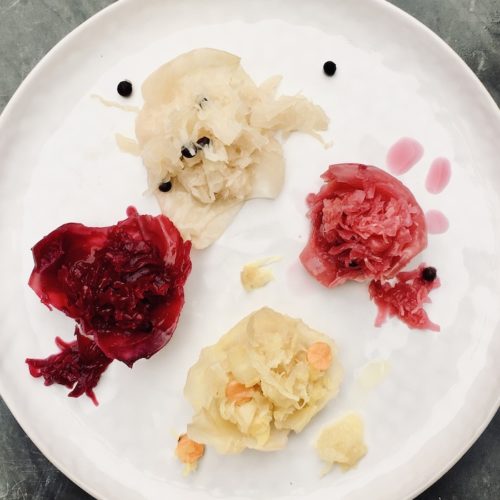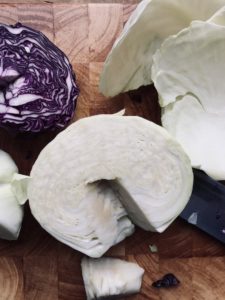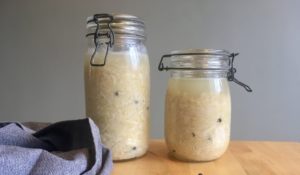
Sauerkraut
WHY?Sauerkraut is an easy and cheap source of vitamin C, K, and especially of probiotic bacteria. These in turn are excellent to improve and maintain gut health.
Ingredients
- 1 kg cabbage white, red or a mix for pink Sauerkraut
- 2.5 tbsp salt
- 2 tbsp juniper berries
Instructions
- Remove any damaged outer leaves, remove two to four big leaves and set aside for later. Cut the cabbage in two and remove core.
- Cut each piece in two again so that you end up with cabbage quarters. Slice these in very thin strips and toss in a bowl. You can use a food processor for this step.

- Add the salt and slightly mix with your hands. Let sit for 20 min until the cabbage starts to release some water, then squeeze the cabbage with your hands until it has become quite limp and significantly reduced in volume. You should see liquid accumulating at the bottom of the bowl.

- Add the juniper berries and start transferring it into a glass jar or ceramic fermentation vessel. Pack it down tightly to avoid air bubbles and for the kraut to be fully covered by its juice. I like to use my fist to pound it down but you can also use a professional kraut pounder or a big wooden spoon.
- It’s important that all of the cabbage is fully submerged by its juice and nothing is exposed to air during the fermentation process. There are several ways to do that. I like to place a layer of whole cabbage leaves on top of the sauerkraut, then put a small glass jar on top that will be held down by the lid of my glass jar. There are also professional fermentation stones or glass weights that you can buy.

- During the fermentation process carbon dioxide is being released. This means that if you close your jar with an airtight lid, you will have to release the pressure every now and then, at the beginning every day. To avoid that you can buy a professional airlock.
- I like to ferment my sauerkraut for a couple of weeks at room temperature (out of direct sunlight) and then transfer it to the fridge for another couple of weeks before I start eating it. The longer you let it ferment the more sour it gets. Sauerkraut keeps well in the fridge for a very long time (easily up to a year).
Notes
The more sauerkraut you ferment in one vessel, the longer it takes to fully ferment. If you ferment in very small quantities your kraut might be ready in a few days. Also a higher room temperature leads to a faster fermentation process.
How to know if your sauerkraut is actively fermenting?
After a few days you will see foamy bubbles form on top of your sauerkraut. If your fermentation vessel has an airtight lid, you will hear the sound of gas releasing when opening it - similar to opening a bottle of beer or other carbonated beverage.
After a few days you will see foamy bubbles form on top of your sauerkraut. If your fermentation vessel has an airtight lid, you will hear the sound of gas releasing when opening it - similar to opening a bottle of beer or other carbonated beverage.